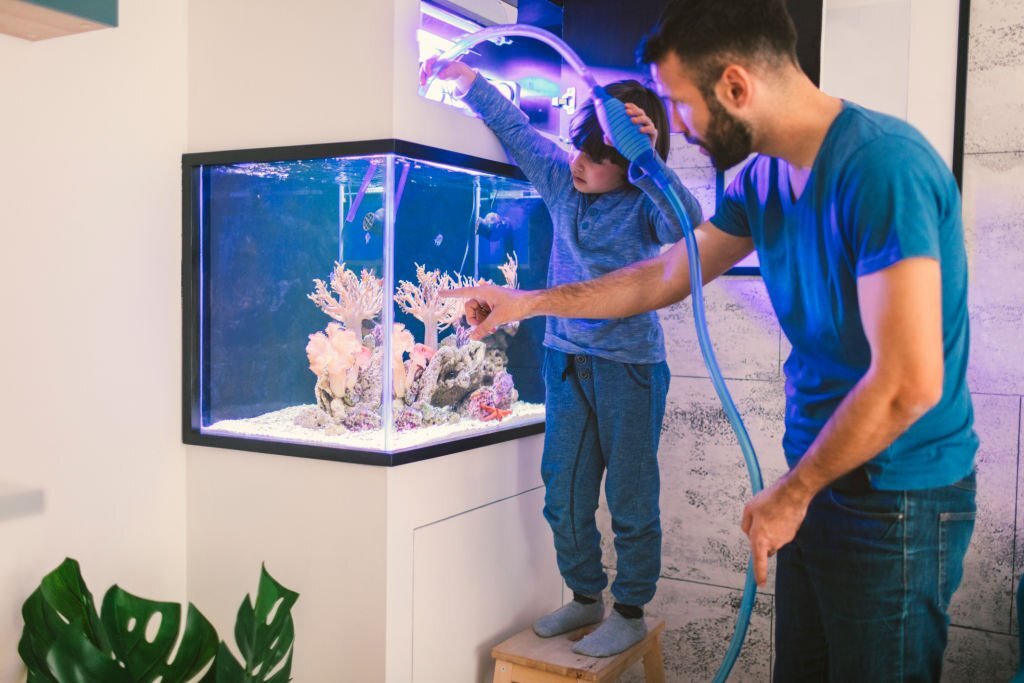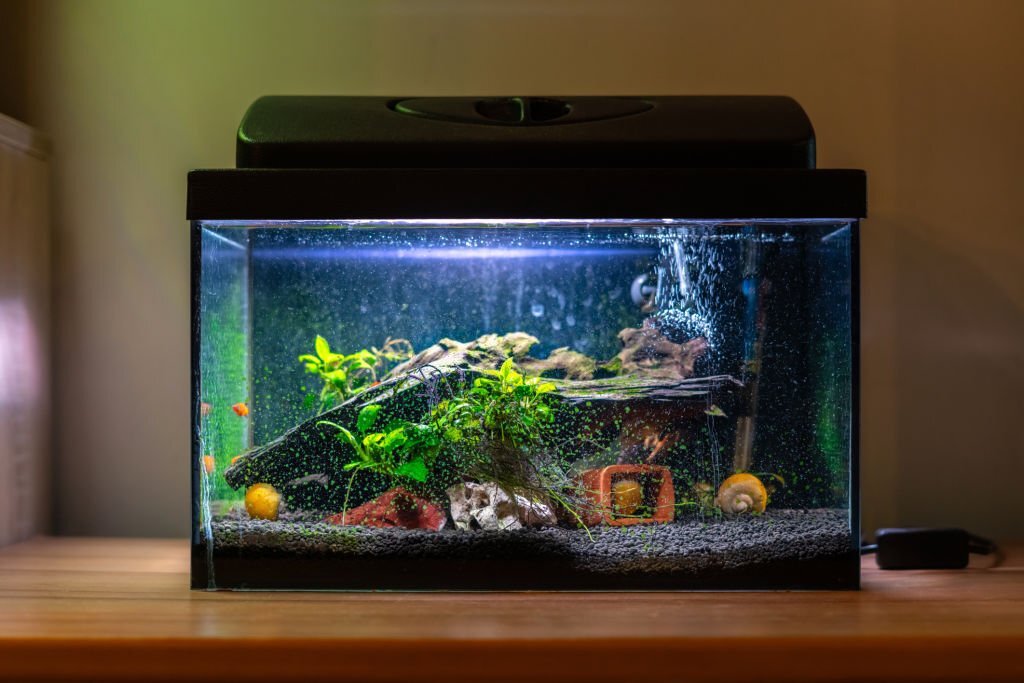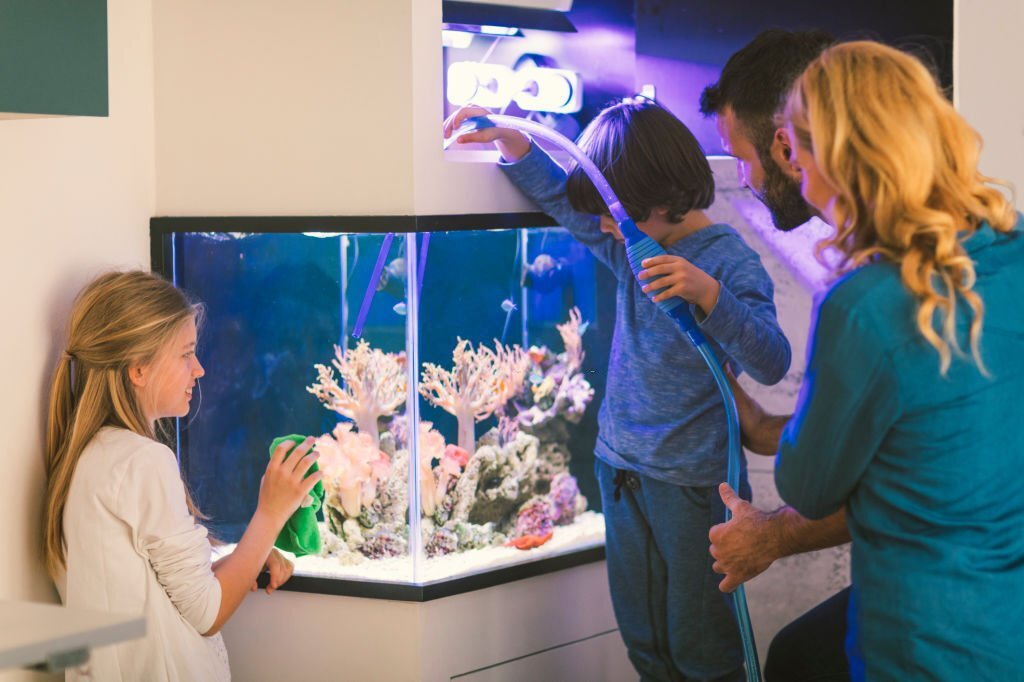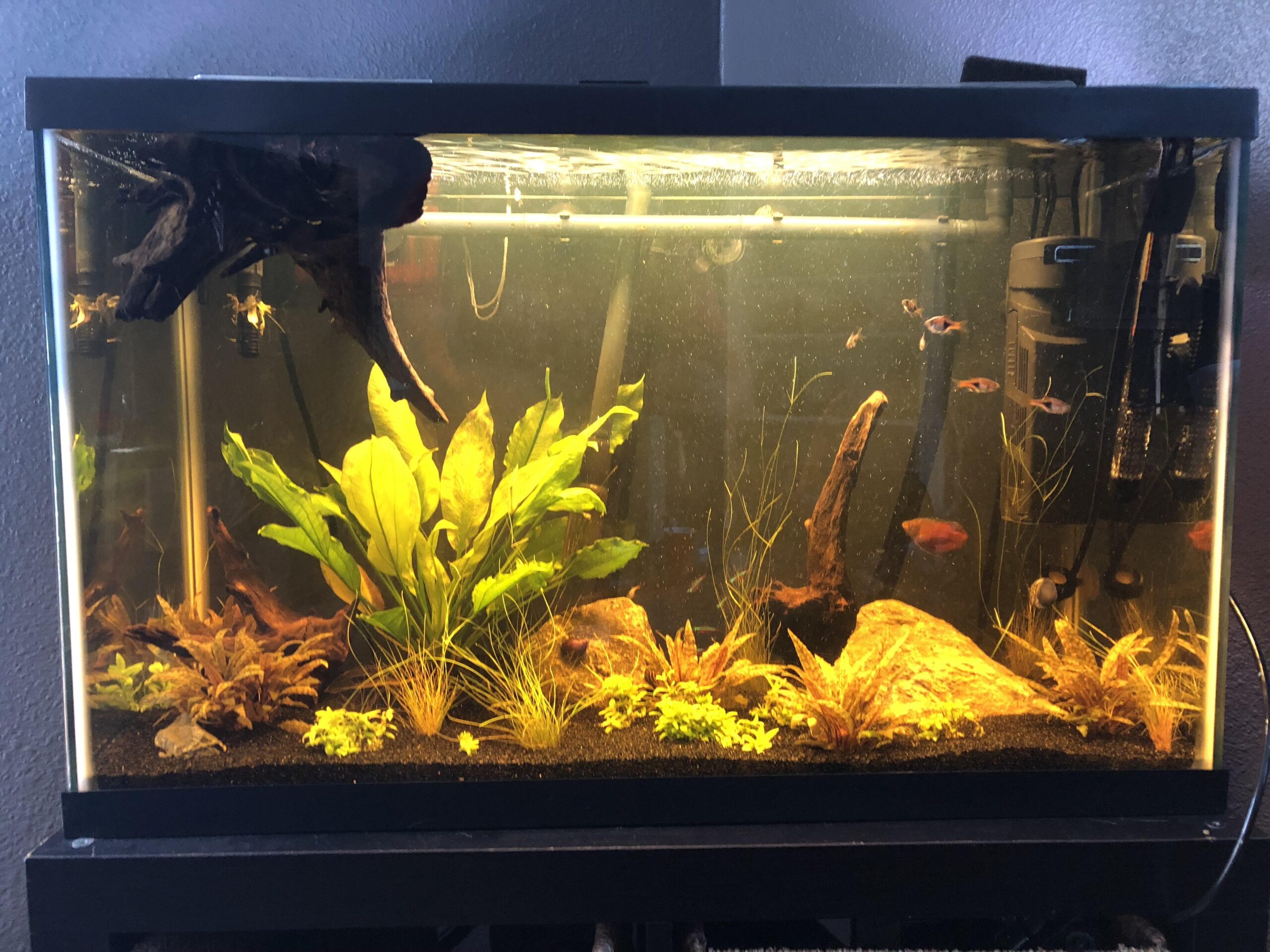Smartplantedaquarium.com participates in affiliate marketing programs. We may earn commissions on purchases made through our affiliate links. This doesn't affect our content or recommendations and we only recommend products we would put in our own tanks.
Do your fish seem unhappy in your aquarium? It might be because of the water’s hardness. Aquarium water hardness can affect your fish’s health and well-being. Don’t worry; you’re not alone. Many aquarium enthusiasts face this challenge.
In this guide, we’ll explore some straightforward methods to soften your aquarium water, ensuring a healthier and happier environment for your aquatic friends. So, let’s dive in and discover how to make your fish feel right at home!
Contents
Key Takeaways
- Aquarium water hardness refers to the concentration of dissolved mineral salts, primarily calcium and magnesium, in the water.
- Water hardness can be categorized into two types: general hardness (GH) and carbonate hardness (KH).
- Hard water can be problematic in aquariums as it can affect the health and well-being of aquatic life, pH stability, plant growth, and medication efficacy.
- Water hardness can be measured using test kits, test strips, electronic meters, water supply reports, or laboratory analysis.
- The ideal hardness level for an aquarium depends on the specific needs of the aquatic species. Different setups have different recommended hardness ranges.
- There are several methods to soften aquarium water, such as using distilled or reverse osmosis (RO) water, peat moss, driftwood, water softening pillows or resins, rainwater, commercial water softeners, water conditioners, Indian almond leaves (IAL), and softening filters or water softening systems.
- Each method has its advantages and challenges, so aquarists should choose the method that suits their specific needs and preferences.
- It’s important to monitor and adjust water hardness to maintain a healthier and more harmonious environment for aquarium inhabitants.
What is Water Hardness in the Aquarium
Water hardness in an aquarium refers to the concentration of dissolved mineral salts, primarily calcium and magnesium, present in the water. It’s a critical parameter that affects the health and well-being of aquatic life, as well as the overall balance of the tank’s ecosystem. Water hardness can be categorized into two main types:
- General Hardness (GH): This measures the total amount of dissolved calcium and magnesium ions in the water. GH is often expressed in degrees (dGH) or parts per million (ppm). A higher GH indicates “hard” water, while a lower GH indicates “soft” water.
- Carbonate Hardness (KH): Also known as alkalinity, KH measures the concentration of carbonate (CO₃²⁻) and bicarbonate (HCO₃⁻) ions. These ions act as a buffer, helping maintain a stable pH level in the aquarium.
Water hardness is naturally determined by the geological composition of the area from which the water is sourced. For instance, water from limestone regions tends to be hard due to the high calcium content, while water from areas with granite or rainwater is typically soft.
Understanding and monitoring water hardness is essential for aquarium hobbyists. Different aquatic species have specific hardness requirements, and deviations from these can lead to stress, health issues, or even premature death. Moreover, water hardness can influence various chemical processes in the tank, including pH stability and nutrient availability.
How Does Water Become Hard
Water becomes “hard” primarily due to its interaction with certain types of rock and soil, which results in the absorption of mineral salts. The process is natural and occurs as follows:
- Rainwater Absorption: Rainwater is naturally soft. However, as it percolates through the ground, it can dissolve minerals from rocks and soil, especially those containing limestone, chalk, and gypsum.
- Mineral Dissolution: The primary minerals that contribute to water hardness are calcium and magnesium. When water interacts with rocks rich in these minerals, it dissolves them, leading to an increased concentration of calcium and magnesium ions.
- Source of Water: Regions with a significant amount of limestone or chalk in their geological composition tend to have harder water. Conversely, areas dominated by granite or sandstone produce softer water.
Why is Hard Water Problematic in Aquariums
While hard water isn’t inherently harmful, it can present several challenges in an aquarium setting:
- Species-Specific Needs: Different aquatic species have evolved in varied environments with specific water hardness levels. Some species thrive in hard water, while others prefer soft water. Subjecting fish or plants to inappropriate water hardness can cause stress, health complications, or reduced lifespan.
- pH Stability: Hard water, especially with a high KH, can act as a buffer, preventing pH shifts. While this might seem beneficial, it can be problematic when trying to adjust the pH to suit specific species.
- Mineral Build-up: Hard water can lead to mineral deposits on aquarium equipment, decorations, and even the glass walls. This build-up, often seen as a white, chalky residue, can be unsightly and challenging to remove.
- Impact on Plant Growth: Some aquatic plants struggle in hard water conditions. The high mineral content can inhibit the absorption of essential nutrients, leading to stunted growth or discoloration.
- Interference with Medications: Hard water can sometimes interfere with the efficacy of certain medications or treatments, making it harder to treat sick fish effectively.
While hard water is not a problem in itself, its implications on the aquarium’s inhabitants and the overall ecosystem make it a significant consideration for aquarists. Adjusting water hardness to suit the needs of the tank’s occupants ensures a healthier and more harmonious environment.
How is Water Hardness Measured
Understanding the level of hardness in your aquarium water is crucial for maintaining a healthy environment for your aquatic inhabitants. Measuring water hardness can be done using several methods, each providing insights into the mineral content of the water.
Test Kits
- Liquid Test Kits: These are among the most common tools used by aquarists. By adding a specific reagent to a water sample, a color change will occur. The degree of color change, often compared to a color chart, indicates the hardness level.
- Test Strips: These are strips impregnated with chemicals that react and change color when dipped into the aquarium water. By comparing the strip’s color to a provided chart, you can determine the hardness.
Electronic Meters: Digital meters provide a quick and accurate reading of water hardness. They often measure Total Dissolved Solids (TDS), which can give an indication of overall water hardness, though they won’t differentiate between types of dissolved solids.
Water Supply Reports: For those who use tap water in their aquariums, local water supply companies often provide reports detailing the water’s mineral content, including its hardness. These reports give a general idea, but it’s worth noting that water hardness can vary slightly throughout the year.
Degrees and Parts Per Million (ppm): Once you’ve measured the hardness, it’s commonly expressed in two ways:
- Degrees of General Hardness (dGH): One degree of general hardness corresponds to 10 mg of calcium oxide per liter.
- Parts Per Million (ppm): Sometimes, hardness is expressed as ppm or mg/L. This measurement indicates the concentration of calcium and magnesium ions in the water.
Laboratory Analysis: For those seeking a comprehensive understanding of their water composition, sending a water sample to a laboratory can provide detailed insights into all aspects of water quality, including hardness.
Recommended Range for Aquarium Water Hardness
The ideal hardness level for your aquarium largely depends on the specific needs of its inhabitants. Different aquatic species have evolved in various environments and, as a result, have distinct water hardness preferences. Here are some general guidelines based on common types of aquarium setups:
- Freshwater Community Aquariums
- General Hardness (GH): 3-12 dGH (50-200 ppm)
- Carbonate Hardness (KH): 3-10 dKH
- African Cichlid Tanks
- These fish are native to the African Rift Lakes, which have hard, alkaline water.
- General Hardness (GH): 10-20 dGH (180-350 ppm)
- Carbonate Hardness (KH): 6-20 dKH
- Discus and Amazon Biotope Tanks
- These setups try to mimic the soft, acidic waters of the Amazon.
- General Hardness (GH): 1-4 dGH (20-70 ppm)
- Carbonate Hardness (KH): 1-3 dKH
- Planted Tanks
- Many aquatic plants prefer softer water, although there are exceptions.
- General Hardness (GH): 3-8 dGH (50-140 ppm)
- Carbonate Hardness (KH): 3-8 dKH
- Brackish Water Tanks
- These tanks house species that thrive in water that’s between freshwater and marine saltwater in salinity.
- General Hardness (GH): 12-20 dGH (200-350 ppm)
- Carbonate Hardness (KH): 10-15 dKH
- Saltwater or Marine Tanks:
- While marine tanks focus more on salinity than hardness, maintaining appropriate calcium and magnesium levels is essential for coral growth.
- General Hardness (GH): Typically not the primary concern. Focus is more on specific calcium and magnesium concentrations.
- Calcium levels: 380-450 ppm
- Magnesium levels: 1250-1350 ppm
How to Soften Aquarium Water
Aquarists often need to adjust the hardness of their aquarium water to suit the specific requirements of their aquatic life. If you find that your water is too hard and need to soften it, here are several effective methods:
1. Distilled or Reverse Osmosis (RO) Water
Both distilled and reverse osmosis (RO) water are purified forms of water with most of their impurities, including minerals, removed. Distilled water is produced by boiling water and collecting the steam. As the steam cools, it condenses back into water, leaving behind most contaminants and minerals. RO water, on the other hand, is created by forcing water through a semipermeable membrane. This membrane allows water molecules to pass through but blocks larger molecules and ions, effectively removing a significant portion of contaminants and minerals.
Advantages: Both methods provide pure water, allowing for precise dilution of hard tap water. Using an RO system at home provides a continuous supply of purified water tailored for aquarium use.
Challenges: Pure RO or distilled water lacks essential minerals that fish and plants need. Using it exclusively can lead to mineral deficiencies unless these minerals are replenished with commercial remineralizers or specific aquarium salts.
2. Peat Moss
Peat moss naturally releases humic and tannic acids into the water. These compounds can bind with calcium and magnesium ions, effectively reducing the hardness of the water. The released humic and tannic acids from peat moss can also acidify the water, leading to a decrease in pH. This is especially beneficial for fish and plants that thrive in acidic environments.
Advantages: It offers a natural way to soften water and can mimic the “blackwater” habitats from which many tropical fish originate.
Challenges: The amount of softening varies depending on the peat’s source and age. It can also impart a brownish tint to the water, which might not be appealing to every aquarist.
3. Driftwood
As driftwood decomposes, it releases tannins into the water. Tannins can help soften the water by binding with certain minerals, thereby reducing overall water hardness. The tannins released by driftwood can also slightly acidify the water, lowering the pH, which can be beneficial for species that thrive in more acidic conditions.
Advantages: Beyond water softening, driftwood serves as a natural decoration, can be a food source for some species, and provides shelter.
Challenges: The initial tannin release can be quite strong. Pre-soaking or boiling can help reduce this. Some types of driftwood may affect water parameters more than others.
4. Water Softening Pillows or Resins
Water softening pillows or resins are specialized products designed to help reduce the hardness of aquarium water. The resin beads within the pillows are charged with sodium ions. When hard water passes over these beads, the calcium and magnesium ions in the water are attracted to and held by the resin. In exchange, the resin releases its sodium ions into the water. This exchange effectively reduces the concentration of hardness-causing minerals.
Advantages: They offer a targeted approach and can be easily placed in most filters.
Challenges: Over time, the resin becomes saturated and must either be regenerated using a salt solution or replaced. Some aquatic species may be sensitive to increased sodium levels.
5. Rainwater
Rainwater is naturally soft, meaning it has a low mineral content. This is because it’s essentially distilled water from the process of evaporation and condensation in the water cycle. Moreover, freshly collected rainwater is usually slightly acidic, often having a pH below 7. This is due to the absorption of carbon dioxide from the atmosphere, forming weak carbonic acid.
Advantages: It’s a natural and cost-effective solution, especially in areas with frequent rainfall.
Challenges: Collection methods should ensure that the rainwater isn’t contaminated by pollutants. It might need additional filtration or treatment before adding to an aquarium.
6. Commercial Water Softeners
Commercial softeners use chemicals that bind with hardness-causing minerals, neutralizing their effect or precipitating them out of the water. These products can act quickly, making them especially useful if there’s an urgent need to adjust water hardness. They are typically straightforward to use, often requiring just the addition of a specified amount to the aquarium.
Advantages: They offer a convenient way to quickly adjust water hardness, especially during emergencies.
Challenges: Over-reliance can lead to imbalances. It’s essential to choose a product that’s suitable for the specific type of aquatic life in the aquarium.
7. Water Conditioners
Water conditioners neutralize harmful substances like chlorine and/or chloramines, rendering the water safe for aquatic life. They can also bind to and neutralize heavy metals such as lead, copper, and zinc, which might be present in tap water and can be harmful to fish. Moreover, certain water conditioners contain ingredients designed to support fish health, such as aloe vera or other colloids, which can help protect fish by forming a slime coat. Some conditioners also help stabilize or adjust the pH of the water, ensuring it stays within a range suitable for the aquarium’s inhabitants.
Advantages: They’re easy to use and act quickly. Most aquarists already use conditioners to treat tap water, so it might not require an additional product.
Challenges: The softening effect might be temporary, and not all water conditioners have softening capabilities.
8. Indian Almond Leaves (IAL)
As IAL decomposes in water, it releases tannins. These tannins can soften the water, reduce pH, and impart a tea-colored tint, which mimics the natural blackwater habitats of many tropical fish. IAL is also believed to possess natural antibacterial and antifungal properties. This makes them especially popular among breeders, as the leaves can help prevent infections in eggs and offer a healthier environment for fry.
Advantages: They provide a natural method to soften water and are widely used in betta and shrimp tanks to mimic natural conditions.
Challenges: They can discolor the water and decompose over time, necessitating replacement. The softening effect can vary depending on the quantity and quality of the leaves.
9. Softening Filters or Water Softening Systems
Softening filters and water softening systems are designed to remove hardness-causing minerals from water, primarily calcium and magnesium. They provide a consistent supply of softened water, which can be invaluable for aquariums housing species that require specific water hardness levels. Based on the aquarium’s size and specific requirements, choose a system that suits your needs. For smaller aquariums, softening pillows or cartridges might suffice, while larger setups might benefit from dedicated systems.
Advantages: They provide a consistent supply of softened water, which is especially useful for large tanks or multiple aquarium setups.
Challenges: Initial setup can be expensive, and systems may require regular maintenance and replenishment of salt or other media.
Conclusion
Softening aquarium water is a crucial aspect of maintaining a healthy aquatic environment for your fish and other aquatic inhabitants. Whether you need to lower the water hardness due to specific species requirements or simply want to improve water quality, there are various methods available to achieve the desired results.
From using commercial water conditioners to incorporating natural methods like adding peat moss or using reverse osmosis water, it’s essential to carefully monitor water parameters and make adjustments gradually to avoid stressing your aquatic life.
Always remember that maintaining stable water conditions is key to the well-being of your aquarium inhabitants, and regular testing and observation will help you provide the best possible environment for them.
Frequently Asked Questions
1. Why is my aquarium water hardness high?
Aquarium water hardness can be high due to various reasons. One common cause is the use of tap water that inherently has a high mineral content, primarily calcium and magnesium. Additionally, certain substrates and decorations, like limestone or coral sand, can leach minerals into the water, increasing its hardness. Over time, as water evaporates from the aquarium and is topped off, the concentration of these minerals can increase, leading to higher hardness levels.
2. Why is my aquarium water hardness low?
Low water hardness in an aquarium could be a result of using purified water sources such as distilled water, reverse osmosis (RO) water, or rainwater, all of which naturally have low mineral content. Additionally, certain elements in the tank, like driftwood or peat moss, can release tannins that soften the water. Overusing water conditioners or softening agents can also lead to reduced hardness levels.
3. Can incorrect water hardness harm fishes and plants?
Yes, incorrect water hardness can have an impact on both fishes and plants. Fishes and plants have specific hardness preferences based on their natural habitats. Fish exposed to inappropriate hardness levels can experience stress, which can weaken their immune system and make them more susceptible to diseases. For plants, incorrect water hardness can affect nutrient uptake and overall growth. It’s essential to match the water parameters with the specific needs of your aquarium’s inhabitants for their optimal health.
4. Do fish like soft water?
Some fish, especially those originating from blackwater habitats like the Amazon basin, prefer soft water. Species such as discus, tetras, and angelfish naturally inhabit waters with low mineral content. Keeping these species in soft water can enhance their coloration, behavior, and overall well-being. However, it’s important to note that not all fish prefer soft water; some require harder water for optimal health.
5. Do plants like soft water?
Many aquatic plants can thrive in a range of water hardness levels. However, certain plants, especially those native to soft water habitats, may prefer softer conditions. Soft water can enhance the absorption of essential nutrients, promoting better growth and coloration. On the other hand, some plants benefit from the minerals found in harder water, so it’s essential to understand the specific needs of the plants in your aquarium.
6. How to make tap water safe for fishes and plants?
To make tap water safe for fishes and plants, one primary concern is neutralizing chlorine and chloramines, commonly added to municipal water supplies as disinfectants. Water conditioners or dechlorinators are readily available products that can quickly neutralize these harmful substances. Additionally, letting tap water sit for 24-48 hours can allow chlorine to evaporate, though this method won’t remove chloramines.
7. Should I reduce water hardness rapidly?
It’s generally not advisable to make rapid changes to any water parameters, including hardness. Sudden shifts can stress fish and plants, leading to potential health issues. If adjustments to water hardness are needed, it’s best to do so gradually over several days or weeks. Slowly mixing the current aquarium water with softer or harder water during regular water changes is a safe way to achieve the desired hardness level without shocking the tank’s inhabitants.



